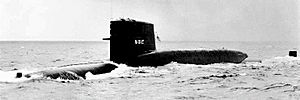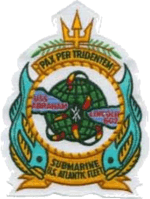USS Abraham Lincoln (SSBN-602) facts for kids

Abraham Lincoln travelling on the surface
|
|
Quick facts for kids History |
|
|---|---|
| Namesake | Abraham Lincoln |
| Ordered | 30 July 1958 |
| Builder | Portsmouth Naval Shipyard |
| Laid down | 1 November 1958 |
| Launched | 14 May 1960 |
| Sponsored by | Mrs. Mary L. Beckwith |
| Commissioned | 11 March 1961 |
| Decommissioned | 28 February 1981 |
| Stricken | 1 December 1982 |
| Fate | Recycled via Submarine recycling 10 May 1994 |
| Badge |  |
| General characteristics | |
| Class and type | George Washington-class submarine |
| Displacement |
|
| Length | 381.6 ft (116.3 m) |
| Beam | 33 ft (10 m) |
| Draft | 29 ft (8.8 m) |
| Propulsion | |
| Speed |
|
| Range | unlimited except by food supplies |
| Test depth | 700 ft (210 m) |
| Complement | Two crews (Blue/Gold) each consisting of 12 officers and 100 enlisted |
| Armament |
|
The USS Abraham Lincoln (SSBN-602) was a special type of submarine called a fleet ballistic missile submarine. It was the first ship in the United States Navy to be named after Abraham Lincoln, who was the 16th President of the United States.
The building of the Abraham Lincoln started on November 1, 1958, at the Portsmouth Naval Shipyard in Kittery, Maine. It was officially "launched" into the water on May 14, 1960. Mrs. Mary L. Beckwith, a great-granddaughter of President Lincoln, was the ship's sponsor. The submarine was "commissioned" (meaning it officially joined the Navy) on March 8, 1961. It had two crews, a Blue Crew and a Gold Crew, who would take turns operating the submarine.
Contents
Life in the Atlantic Ocean
The Abraham Lincoln began its journey on March 20, 1961. It went to Cape Canaveral, Florida, for "shakedown" tests, which are like a trial run to make sure everything works. After some repairs, it went to Charleston, South Carolina, to load its missiles.
In August 1961, the submarine became part of a group called SUBRON 14. It then traveled to Holy Loch, Scotland, in October 1961. This port became its main base for the next four years. The Abraham Lincoln would go on "deterrent patrols" from Holy Loch. These patrols were important during the Cold War to show that the United States had powerful weapons ready.
Responding to the Cuban Missile Crisis
A very important event happened in October 1962 during the Cuban Missile Crisis. This was a tense time when the United States and the Soviet Union were close to conflict. The Abraham Lincoln was supposed to be getting maintenance, but it quickly received orders to go on patrol. It left right away and successfully completed a 65-day patrol, showing its readiness.
In October 1965, the Abraham Lincoln returned to the United States. It went into the Electric Boat shipyard in Groton, Connecticut, for a major update and to refuel its nuclear reactor. This work finished in June 1967. The submarine then went back to Holy Loch and continued its important deterrent patrols.
Moving to the Pacific Ocean
In early 1972, the Abraham Lincoln left Scotland and sailed back to the United States. It arrived in Groton, Connecticut, in April 1972. After some visits, it headed to the West Coast of the United States. It sailed through the Panama Canal in June. The submarine stopped in Bangor, Washington, to unload its missiles. Then, it went to the Mare Island Naval Shipyard in Vallejo, California, for another big overhaul and refueling.
Life in the Pacific Ocean
The major updates were finished in December 1973. After more tests, the Abraham Lincoln went through the Panama Canal again in June 1974. It stopped for more tests in Florida and South Carolina. Then, it returned through the Panama Canal and sailed to its new home port, Pearl Harbor, Hawaii, arriving in September 1974.
From Hawaii, the submarine moved to its advanced base in Guam in October 1974. From Guam, it started new deterrent patrols in the Mariana Islands. It continued these patrols until 1978. During this time, the Abraham Lincoln made history by completing its 50th strategic deterrent patrol in 1978. This was a big achievement for a ballistic missile submarine.
Retirement and Recycling
The Abraham Lincoln finished its very last patrol in October 1979. It arrived at Bangor, Washington, on October 30, 1979, to unload its missiles. The submarine then began the process of getting ready for retirement.
The Abraham Lincoln was officially "decommissioned" (taken out of service) on February 28, 1981. It was removed from the Navy's list of ships in December 1982. Finally, the submarine was recycled through the Ship-Submarine Recycling Program on May 10, 1994, at the Puget Sound Naval Shipyard. This program safely takes apart old nuclear submarines.
A part of the Abraham Lincoln's "sail" (the tower-like structure on top of the submarine) was later used to fix another submarine, the USS George Washington. This part of the sail is now on display at the Submarine Force Library and Museum near Groton, Connecticut.
Images for kids
This article incorporates text from the public domain Dictionary of American Naval Fighting Ships. The entry can be found here.
This article incorporates text from the public domain Dictionary of American Naval Fighting Ships. The entry can be found here.



